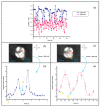Anomalous Lehmann Rotation of Achiral Nematic Liquid Crystal Droplets Trapped under Linearly Polarized Optical Tweezers
- PMID: 34299382
- PMCID: PMC8306553
- DOI: 10.3390/molecules26144108
Anomalous Lehmann Rotation of Achiral Nematic Liquid Crystal Droplets Trapped under Linearly Polarized Optical Tweezers
Abstract
Continuous rotation of a cholesteric droplet under the heat gradient was observed by Lehmann in 1900. This phenomenon, the so-called Lehmann effect, consists of unidirectional rotation around the heat flux axis. We investigate this gradient heat effect using infrared laser optical tweezers. By applying single trap linearly polarized optical tweezers onto a radial achiral nematic liquid crystal droplet, trapping of the droplet was performed. However, under a linearly polarized optical trap, instead of stable trapping of the droplet with slightly deformed molecular directors along with a radial hedgehog defect, anomalous continuous rotation of the droplet was observed. Under low power laser trapping, the droplet appeared to rotate clockwise. By continuously increasing the laser power, a stable trap was observed, followed by reverse directional rotation in a higher intensity laser trap. Optical levitation of the droplet in the laser beam caused the heat gradient, and a breaking of the symmetry of the achiral nematic droplet. These two effects together led to the rotation of the droplet under linearly polarized laser trapping, with the sense of rotation depending on laser power.
Keywords: Lehmann effect; Lehmann rotation; achiral nematic; liquid crystals; optical tweezers.
Conflict of interest statement
The authors declare no conflict of interest. The funders had no role in the design of the study; in the collection, analyses, or interpretation of data; in the writing of the manuscript, or in the decision to publish the results.
Figures








References
-
- Lehmann O. Structur, System und magnetisches Verhalten flüssiger Krystalle und deren Mischbarkeit mit festen. Ann. Phys. 1900;2:649–705. doi: 10.1002/andp.19003070802. - DOI
-
- Leslie F.M., Green A.E. Some thermal effects in cholesteric liquid crystals. Proc. Soc. A. 1968;307:359–372.
Grants and funding
LinkOut - more resources
Full Text Sources

